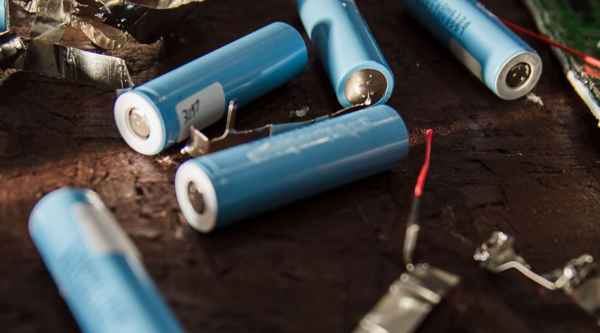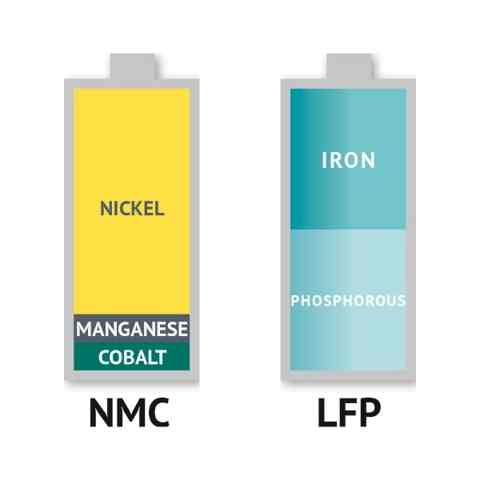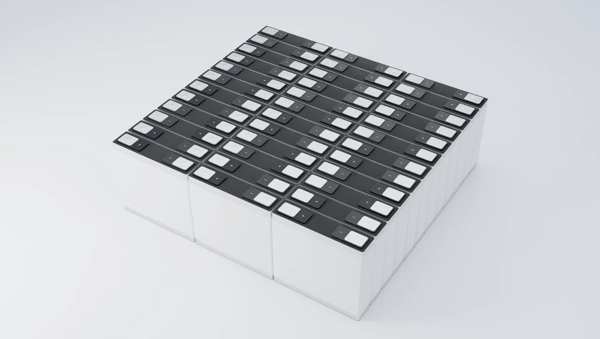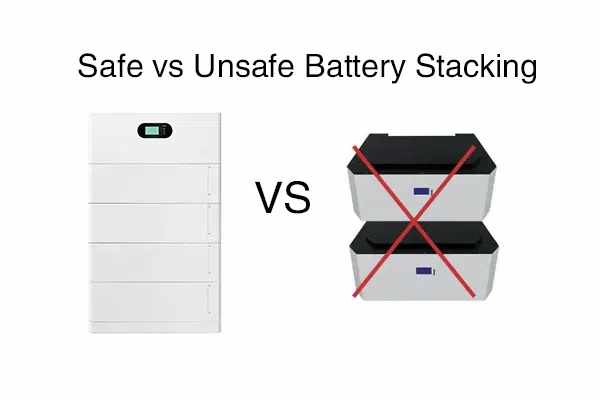أي نوع من بطارية الليثيوم سوف يستمر أطول وقت?
عندما تستثمر في نظام تخزين البطارية لمنزلك أو عملك, أحد الأسئلة الأكثر أهمية, "كم من الوقت سيستمر هذا?" تريد اختيار تقنية توفر أقصى قدر من المتانة وتوفر عائدًا كبيرًا على استثمارك على مدار سنوات عديدة. لذا, داخل عالم بطاريات الليثيوم المتقدمة, أي نوع يقف حقًا اختبار الزمن?
لتطبيقات تخزين الطاقة الثابتة مثل النسخ الاحتياطي الشمسي أو المعيشة خارج الشبكة, الفوسفات الحديد الليثيوم (LFP أو LIFEPO₄) توفر البطاريات باستمرار أطول عمر وأكثرها موثوقية. مع وجود دورة تدريبية نموذجية في كثير من الأحيان تتجاوز 3,000 ل 6,000 دورات تفريغ الشحنة الكاملة وحياة تقويم محتملة 10 ل 20 سنين, تقنية LFP هي الخيار المتفوق لأي شخص يسعى إلى المدى الطويل, أداء يمكن الاعتماد عليه. هذا هو السبب في أنها كيمياء الاختيار لبطاريات الليثيوم القابلة للتكديس عالية الجودة.

في جيكس سولار, نضع الأولوية للقيمة والموثوقية على المدى الطويل لعملائنا. لهذا السبب تم تصميم منتجات بطارية الليثيوم القابلة للتكديس التي نقدمها على كيمياء LFP. لكن ما الذي يجعلهم يدوم وقتًا طويلاً, وما هي العوامل التي يمكن أن تقصر هذا العمر? دعنا نغوص.
ما الذي يقصر حياة بطاريات الليثيوم?
تريد الحصول على أقصى استثمار في البطارية, لذلك من الأهمية بمكان أن نفهم العوامل التي يمكن أن تسبب لها العمر قبل الأوان. قلق من أن بعض الشروط أو العادات قد تسبب أضرارًا خفية? معرفة ما هو تقصير عمر البطارية هي الخطوة الأولى لزيادة ذلك.
يتم تقصير عمر أي بطارية ليثيوم في المقام الأول من خلال بعض الضغوطات الرئيسية: التعرض لدرجات حرارة عالية, متكرر تصريفات عميقة جدا, عالية باستمرار معدلات الشحن والتفريغ (تيار مرتفع), والاحتفاظ بها في حالات الاتهام المتطرفة (أيضاً 100% كامل أو 0% فارغ) لفترات طويلة. نظام إدارة البطارية جودة (خدمات إدارة المباني), وهو جزء لا يتجزأ من بطاريات الليثيوم القابلة للتكديس الحديثة, يلعب دورًا حيويًا في حماية البطارية من هذه الضغوط.

الغوص أعمق: أعداء بطارية طول العمر
دعونا نلقي نظرة على كل من هذه العوامل بمزيد من التفصيل:
- درجات حرارة عالية: الحرارة هي العدو رقم واحد لصحة البطارية. تخزين أو تشغيل بطارية في بيئة ساخنة (على سبيل المثال, فوق 30 درجة مئوية / 86° F باستمرار) يسرع عمليات التدهور الكيميائي داخل الخلايا. هذا يؤدي إلى فقدان السعة بشكل أسرع وعمر إجمالي أقصر. هذا هو السبب في أن التهوية المناسبة والإدارة الحرارية لنظام البطارية الخاص بك مهمان للغاية.
- عمق التفريغ العميق (وزارة الدفاع): في حين أن بطاريات LFP قوية, تعاني جميع البطاريات من المزيد من التوتر خلال دورات أعمق. بطارية يتم تصريفها بانتظام إلى فقط 50% سوف تستمر قدرتها لدورات أكثر بكثير من نفس البطارية التي يتم تصريفها بانتظام 90% أو 100%. تحجيم بنك البطارية الخاص بك بشكل مناسب حتى لا تضطر إلى استنزافه بالكامل كل يوم هو استراتيجية رئيسية لطول العمر.
- ارتفاع معدلات الشحن/التفريغ (قفص): شحن البطارية أو تفريغها بسرعة كبيرة (في "معدل C" مرتفع) يولد المزيد من الحرارة الداخلية ويمكن أن يضع الضغط الفيزيائي على مواد القطب الكهربائي. بينما ضروري في بعض الأحيان, باستخدام أبطأ, دورات شحن وتفريغ ألطف عند الإمكان أفضل لصحة البطارية على المدى الطويل.
- حالة شحنة متطرفة (شركة نفط الجنوب):
- عالية SOC (100%): ترك بعض أنواع بطاريات الليثيوم أيون (على وجه الخصوص Chemistries NMC/LCO الموجودة في الإلكترونيات الاستهلاكية) يجلس في 100% يمكن أن تسبب الرسوم لفترات طويلة تدهور أسرع. LFP أكثر تسامحًا مع الاحتفاظ بتهمة كاملة, وهو سبب آخر أنه مثالي للطاقة الشمسية, ولكن حتى بالنسبة إلى LFP, ليس من المثالي تركه في 100% لشهور متتالية دون استخدام.
- انخفاض سوك (0%): السماح لبطارية الليثيوم بالتصريف بالكامل والجلوس في 0% لفترة طويلة يمكن أن تكون ضارة للغاية ويمكن أن تؤدي في بعض الأحيان إلى حالة لا يمكن استردادها منها.
BMS متطور, مثل تلك الموجودة في بطاريات الليثيوم القابلة للتكديس التي يوفرها GYCX Solar, يعمل بنشاط على الحماية من هذه الظروف من خلال مراقبة درجة الحرارة ومنع البطارية من العمل خارج الجهد الآمن وحدوده الحالية.
هل LifePo4 أفضل من الليثيوم أيون?
ربما تكون قد سمعت المصطلحات "LifePo4" و "ليثيوم أيون," ويمكن أن يكون مربكا. هو LifePo4 (LFP) تقنية مختلفة تمامًا تتنافس مع الليثيوم أيون, أم أنه شيء آخر? دعونا نوضح هذه النقطة الشائعة جدًا للارتباك.
هذا القليل من سؤال الخدعة: LifePo₄ (LFP) هو نوع بطارية الليثيوم أيون. مصطلح "ليثيوم أيون" يشير إلى مجموعة كاملة من كيمياء البطارية. السؤال الأكثر دقة هو, "هل LFP أفضل من آخر كيمياء ليثيوم أيون المشتركة, مثل NMC (الكوبالت المنغنيز النيكل) أو LCO (أكسيد الكوبالت الليثيوم)?" لتطبيقات مثل تخزين الطاقة الشمسية, الجواب مدوي نعم, تعتبر LFP عمومًا تقنية أفضل بسبب سلامتها الفائقة, عمر أطول بكثير, والاستقرار الحراري الممتاز.

الغوص أعمق: اختيار الكيمياء المناسبة للوظيفة
"أفضل" تعتمد الكيمياء حقًا على أولويات التطبيق. دعنا نقارن:
- LifePo₄ (LFP) نقاط القوة - لماذا "أفضل" للتخزين الشمسي والقرطاسي:
- سلامة متفوقة: LFP له بنية كيميائية مستقرة للغاية. تكون درجة حرارة هارب الحرارية أعلى بكثير من درجة NMC أو LCO, وهذا يعني أنه من غير المرجح أن ترتفع درجة حرارته وإطلاق النار إذا تعرضت للإجهاد. هذه هي الميزة الأكثر أهمية لنظام البطارية المثبت في منزلك أو عملك.
- أطول عمر: كما ناقشنا, يقدم LFP آلاف دورات تفريغ الشحن أكثر من NMC أو LCO, مما يجعله استثمارًا أكثر متانة وفعالية من حيث التكلفة على المدى الطويل للأنظمة المستخدمة يوميًا.
- استقرار حراري ممتاز: يعمل LFP جيدًا عبر مجموعة واسعة من درجات الحرارة ويتأثر بالحرارة أقل من الكيمياء الأخرى.
- لا الكوبالت: بطاريات LFP لا تحتوي على الكوبالت, معدن معروف بتقلب الأسعار والمخاوف الأخلاقية فيما يتعلق بممارسات التعدين. هذا يجعل LFP خيارًا أكثر ثباتًا وضميرًا.
- نقاط القوة NMC/LCO - لماذا يتم استخدامها في تطبيقات أخرى:
- ارتفاع كثافة الطاقة: الميزة الرئيسية لـ NMC و LCO هي أنه يمكنهم تخزين المزيد من الطاقة في حزمة أصغر وأخف وزنا. هذا هو السبب في أنها الخيار المفضل للتطبيقات التي يكون فيها الوزن والمساحة عوامل محددة حاسمة, كما في الهواتف الذكية, طائرات بدون طيار, والعديد من السيارات الكهربائية (على الرغم من أن العديد من صانعي EV يتحولون أيضًا إلى LFP للنماذج القياسية المدى بسبب فوائد سلامتها وتكلفة).
لحلول تخزين الطاقة الثابتة التي تصممها GYCX الشمسية وتثبيتها - حيث السلامة, مصداقية, والقيمة طويلة الأجل هي الأولويات العليا- LFP هو بلا شك "العليا و" أفضل" تكنولوجيا الليثيوم أيون. لهذا السبب أوصىنا بطارية الليثيوم القابلة للتكديس المنتجات مبنية على هذه الكيمياء القوية.
ماذا تفعل بطاريات تكديس?
ترى أنظمة تخزين الطاقة الحديثة معلنة على أنها "قابلة للتكديس," لكن ما الذي ينجزه هذا بالفعل? كيف يستفيد ترتيب وحدات البطارية هذه بشكل جسدي معًا? الغرض الأساسي من تكديس البطاريات هو تحقيق قابلية التوسع والمرونة.
بعبارات بسيطة, تتيح لك بطاريات التراص بناء أكبر, نظام تخزين الطاقة المخصص من أصغر, وحدات معيارية موحدة. كهربائيا, هذا يعني أنه يمكنك توصيل الوحدات معًا بالتوازي لزيادة إجمالي قدرتك على الطاقة (كيلووات ساعة) والإخراج الحالي, أو في سلسلة لزيادة إجمالي جهد النظام الخاص بك. جسديا, يسمح بكثافة للغاية, منظم, وتركيب فعال في الفضاء. الأمر كله يتعلق بإنشاء نظام يناسب احتياجاتك تمامًا ويمكن أن ينمو معك بمرور الوقت.

الغوص أعمق: قوة النموذج
إليك كيفية عمل التراص لإنشاء نظام أكثر قوة ومرونة:
- التراص المادي للتنظيم: بطاريات قابلة للتكديس مصممة لهذا الغرض, مثل بطاريات Mount Rack Mount LFP عروض GYCX Solar, تم تصميمها لتناسب معا وأمان معا, في كثير من الأحيان ضمن رف أو خزانة مخصصة. هذا يبقي النظام مضغوط, يحمي البطاريات, يضمن تدفق الهواء المناسب, ويجعل تركيبًا نظيفًا ومهنيًا جدًا مقارنة بوجود بطاريات فردية وأسلاك.
- التراص الكهربائي للقدرة (اتصال مواز): هذا هو الاستخدام الأكثر شيوعًا في التخزين الشمسي السكني والتجاري. قد تكون كل وحدة 48 فولت 100AH (~5kWh) وحدة. عن طريق توصيلهم بالتوازي (إيجابي إلى إيجابي, سلبي إلى سلبي), يبقى الجهد 48 فولت, لكن السعة تضيف.
- 2 الوحدات النمطية بالتوازي = 48 فولت, 200آه (~ 10 كيلوواط ساعة)
- 4 الوحدات النمطية بالتوازي = 48 فولت, 400آه (~ 20 كيلو واط ساعة)
يتيح لك ذلك توسيع تخزين الطاقة بسهولة فقط عن طريق إضافة وحدة أخرى إلى المكدس.
- التراص الكهربائي للجهد (اتصال سلسلة): في حين أقل شيوعًا لأنظمة الطاقة الشمسية المنزلية النموذجية, توصيل الوحدات النمطية في السلسلة (إيجابية إلى سلبية) يضيف الفولتية معًا. يتم استخدام هذا في التطبيقات التي تتطلب جهد DC أعلى مما يمكن أن توفره وحدة واحدة. على سبيل المثال, ستقوم وحدتان 48 فولت في السلسلة بإنشاء نظام 96 فولت.
- تنسيق BMS: في نظام مكدس, أنظمة إدارة البطاريات الفردية (خدمات إدارة المباني) في كل وحدة تعمل معًا, في كثير من الأحيان التواصل مع العاكس الشمسي الرئيسي, لضمان رسوم وتصريفات بنك البطارية بأكمله كفرد, متماسك, ووحدة آمنة.
قصة GYCX الشمسية: "بدأ عميل بنظام بطارية ليثيوم قابل للتكديس 10 كيلو وات ساعة. بعد عامين, لقد اشتروا سيارة كهربائية وأرادوا المزيد من التخزين لشحنها بالطاقة الشمسية. لأنهم اختاروا وحدات, نظام قابل للتكديس, كانت الترقية بسيطة: لقد أضفنا للتو وحدتين أخريين إلى رفهم الحالي, مضاعفة قدرتهم دون الحاجة إلى استبدال استثماراتهم الأصلية."
هل يمكنك تكديس بطاريات الليثيوم فوق بعضها البعض?
هذا سؤال سلامة حاسم. عندما ترى أنظمة البطارية المعيارية هذه, هل يمكنك حرفيًا وضعها مباشرة فوق بعضها البعض? كما هو الحال مع كل الأشياء المتعلقة بسلامة البطارية, تعتمد الإجابة بالكامل على التصميم المحدد للمنتج.
أنت تستطيع فقط مكدس بطاريات الليثيوم بأمان مباشرة فوق بعضها البعض إذا قامت الشركة المصنعة بتصميمها على وجه التحديد لهذا الغرض. ستحتوي هذه الوحدات المصممة خصيصًا على ميزات مثل المعززة, أغلفة الحمل والآليات المتشابكة المادية لضمان أن المكدس مستقر وآمن. بالنسبة للعديد من الآخرين "قابلة للتكديس" الأنظمة, مثل المشترك بطاريات رف الخادم, المصطلح "تكديس" يشير إلى تثبيتها على الرفوف الفردية أو القضبان داخل خزانة أو رف داعم, عدم وضعهم مباشرة على بعضهم البعض لتحمل الوزن. اتبع دائمًا دليل تثبيت الشركة المصنعة.

الغوص أعمق: هندسة التراص الآمن
دعونا نلقي نظرة على الطريقتين الآمنتين لـ "التراص":
- تكديس مباشر (مع الوحدات النمطية المصممة):
- كيف تعمل: عززت هذه الوحدات أغلفة هيكلية مصممة لدعم وزن وحدات أخرى متعددة في الأعلى. غالبًا ما يكون لديهم أخاديد, علامات التبويب, أو محاذاة دبابيس التي تغلقهم معًا بشكل آمن لمنع التحول.
- ماذا للتحقق: ستعمل ورقة بيانات الشركة المصنعة بشكل صريح إذا تم السماح بالتكديس المباشر وسيحدد الحد الأقصى لعدد الوحدات التي يمكن تكديسها عالية.
- رف/خزانة التراص (شائع جدا):
- كيف تعمل: هذه هي الطريقة التي "بطاريات رف الخادم" يتم تثبيتها. بينما يتم تكديسها رأسياً في خزانة, تنزلق كل وحدة بطارية فردية إلى مجموعة من القضبان القوية أو رف مخصص. يوفر إطار الرف الدعم الهيكلي الكامل لكل وحدة.
- فوائد: تضمن هذه الطريقة دعم كل وحدة بشكل آمن, يمنع التوتر على أغلفة البطارية, وتضمن تباعد ثابت بين الوحدات, وهو أمر بالغ الأهمية لتدفق الهواء والتبريد المناسب.
- لماذا لا يمكنك تكديس أي بطارية فقط:
- عدم الاستقرار: البطاريات غير المصممة للتكديس لا تحتوي على ميزات متشابكة ويمكن أن تطرد بسهولة, تشكل مخاطر سلامة خطيرة.
- أضرار الغلاف: غلاف البطارية القياسية غير مصمم لتكون هيكلية, مكون الحمل. يمكن أن يسحق الوزن من الأعلى أو يكسره, مما يؤدي إلى تلف داخلي ودوائر قصيرة محتملة أو تسرب كيميائي.
- ارتفاع درجة الحرارة: سوف تتراكم البطاريات معًا بدون قنوات تدفق الهواء المصممة, مما يؤدي إلى تدهور سريع وخلق خطر حريق.
في GYCX Solar, السلامة أمر بالغ الأهمية. عندما نقوم بتثبيت منتجات بطارية الليثيوم القابلة للتكديس, نفعل ذلك وفقًا للمعايير الصارمة, باستخدام الأرفف والمرفقات المعتمدة التي تضمن الاستقرار الميكانيكي, السلامة الكهربائية, والصحة الحرارية لنظام تخزين الطاقة بأكمله.
عند البحث عن بطارية ليثيوم أطول, الفائز الواضح لتخزين الطاقة الثابتة هو LifePo₄ (LFP1. ) تكنولوجيا. سلامتها المتأصلة ومتانتها هي السبب في أنها أساس أنظمة البطارية القابلة للتكديس الحديثة. من خلال فهم ما يمكن أن تقصر عمر البطارية وكيف تم تصميم هذه الأنظمة المعيارية للعمل بأمان وبشكل سليفي, يمكنك إجراء استثمار قوي ودائم في استقلال الطاقة الخاص بك.
إذا كان لديك المزيد من الأسئلة حول منتجات بطارية الليثيوم القابلة للتكديس أو ترغب في استكشاف كيف يمكن لنظام تخزين طاقة LFP طويل الأمد أن يفيدك, فريق الخبراء لدينا في GYCX Solar هنا للمساعدة. اتصل بنا اليوم للحصول على استشارة شخصية!
فهم مفهوم LFP بحيث يمكنك مقارنة وفهم مفاهيم البيانات المتعلقة بالبطارية بشكل أفضل. سيساعدك هذا على اختيار المنتج الذي يناسب احتياجاتك. ↩
